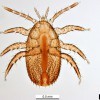Abstract
Honey bees throughout the world are exposed to numerous pests, parasites, and pathogens. One such parasite is Tropilaelaps spp. Delfinado & Baker, an ectoparasitic mite that feeds on the hemolymph of developing honey bees. Four species of Tropilaelaps have been identified and characterized. This 4-page fact sheet was written by Ashley N. Mortensen, Sarah Burleson, Gunasegaran Chelliah, Ken Johnson, Daniel R. Schmehl, and Jamie D. Ellis, and published by the UF Department of Entomology and Nematology, October 2014. (Photo credit: Pest and Diseases Image Library, Bugwood.org)
References
Anderson DL, Roberts JMK. 2013. Standard methods for Tropilaelaps mites research. In Volume II: Standard Methods for Apis mellifera Pest and Pathogen Research, The Coloss BeeBook, Eds. Dietemann V, Ellis JD, Neumann P. Journal of Apicultural Research 52: http://dx.doi.org/10.3896/ibra.1.52.4.21. https://doi.org/10.3896/IBRA.1.52.4.21
Burgett M, Akratanakul P, Morse RA. 1983. Tropilaelaps clareae: A parasite of honeybees in south-east Asia. Bee World 64: 25-28. https://doi.org/10.1080/0005772X.1983.11097904
DeBerry S, Crowley J, Ellis JD. 2012. Swarm control for managed beehives. University of Florida/IFAS, Electronic Data Information Source, ENY-160. (19 July 2013).
Delfinado MD, Baker EW. 1961. Tropilaelaps, a new genus of mite from the Philippines (Laelapidae: Acarina). Fieldiana-Zoology 44: 53-56. https://doi.org/10.5962/bhl.title.3227
Delfinado-Baker M, Baker EW. 1982. A new species of Tropilaelaps parasitic on honeybees. American Bee Journal 112: 416-417.
Ellis JD, Munn PA. 2005. The worldwide health status of honey bees. Bee World 86(4): 88-101. https://doi.org/10.1080/0005772X.2005.11417323
Ellis JD, Zettel Nalen CM. 2013. Varroa destructor Anderson and Trueman (Arachnida: Acari: Varroidae). University of Florida/IFAS Entomology and Nematology Department, Featured Creatures, EENY-473. (29 July 2014).
Mahmood R, Mohsin AU, Asad S, Raja S, Sarwar G. 2014. Integrated control of Tropilaelaps clareae and Varroa destructor in Apis mellifera L. colonies. Journal of Agricultural Science 4: 32-37.
Matheson A. 1997. Country records for honeybee diseases, parasites and pests. Appendix 11. In Honeybee Pests, Predators and Diseases, 3rd edition, Eds. Morse RM, Flottum PK. A. I. Root, Medina OH, USA. pp. 586-602.
Mortensen AN, Schmehl DR, Ellis JD. 2013. Apis mellifera Linnaeus, and subspecies (Insecta: Hymenoptera: Apidae). University of Florida/IFAS Entomology and Nematology Department, Featured Creatures, EENY 568. (29 July 2014).
Pettis JS, Rose R, Lichtenberg EM, Chantawannakul P, Buawangpong N, Somana W, Sukumalanand P, Vanengelsdorp D. 2013. A rapid survey technique for Tropilaelapsmite (Mesostigmata: Laelapidae) detection. Journal of Economic Entomology 106: 1535-1544. doi: http://dx.doi.org/10.1603/EC12339 https://doi.org/10.1603/EC12339
Ritter W. 2014. Tropilaelaps infestation of honey bees (Tropilaelaps spp.) In: Manual of Diagnostic Tests and Vaccines for Terrestrial Animals. World Organization for Animal Health, Paris, France. pp. 420-423.
Tangkanasing P, Wongsiri S, Vongsamanode S. 1988. Integrated control of Varroa jacobsoni and Tropilaelaps clareae in bee hives in Thailand. In: Africanized Honey Bees and Bee Mites. Eds. Needham GR, Page RE, Delfinado-Baker M, Bowman CE. Ellis Horwood Ltd,Chichester, West Sussex, England, pp 409-441.
Woo KS, and Lee JH. 1997. Current status of honeybee mites in Korea. Honeybee Science 18: 175-177.
Woyke J. 1994. Mating behavior of the parasitic honeybee mite Tropilaelaps clareae. Journal of Experimental and Applied Acarology 18: 723-733. doi: http://dx.doi.org/10.1007/BF00051539.

